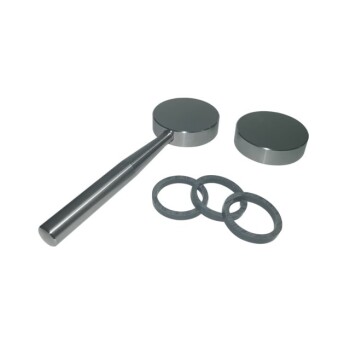An XRF spectrometer, or X-ray fluorescence spectrometer, is a sophisticated analytical instrument used to determine the elemental composition of materials in a non-destructive manner.
It operates by exciting the atoms within a sample with X-rays, causing them to emit secondary X-rays that are characteristic of their elemental composition.
These secondary X-rays are then detected and analyzed to identify and quantify the elements present in the sample.
This technique is widely used across various fields including geology, environmental science, materials science, and metallurgy due to its accuracy, speed, and non-destructive nature.
What Does an XRF Spectrometer Do? 5 Key Points Explained

1. Basic Principle of XRF Spectrometry
Excitation Process: XRF spectrometers use an X-ray source to irradiate the sample.
When the X-rays interact with the sample, they excite the atoms by knocking out inner electrons, creating vacancies in the electron shells.
Fluorescence Emission: The excited atoms then emit secondary X-rays as electrons from higher energy levels fill these vacancies.
Each element emits X-rays with specific energies, which are characteristic of that element.
2. Detection and Analysis
Spectrum Generation: The emitted X-rays are captured by a detector, which processes the data to generate a spectrum.
This spectrum shows peaks corresponding to the energies of the emitted X-rays, allowing identification of the elements present.
Quantitative Analysis: By comparing the intensity of these peaks to known standards, the concentration of each element can be determined, enabling quantitative analysis.
3. Range and Sensitivity
Elemental Range: XRF spectrometers can detect elements ranging from sodium (Na) to uranium (U).
Detection Levels: The sensitivity of detection varies depending on the element and the specific instrument, but it can range from parts per million (ppm) to 100%.
4. Applications and Benefits
Non-Destructive Analysis: One of the key benefits of XRF is its non-destructive nature, allowing samples to be analyzed without alteration.
Versatility: XRF is used in numerous fields including geology, mining, environmental science, and materials science due to its ability to provide quick and accurate elemental analysis.
Portable Options: Handheld XRF analyzers are available, offering the convenience of on-site analysis with results comparable to laboratory-based instruments.
5. Calibration and Customization
Calibration Needs: XRF spectrometers may require calibration for specific applications to ensure accurate results.
Customization for Various Tasks: Modern XRF spectrometers can be calibrated for different tasks, making them versatile tools for a wide range of elemental analysis needs.
In summary, an XRF spectrometer is a powerful tool for elemental analysis, offering a non-destructive, accurate, and versatile method for determining the composition of materials.
Its ability to provide both qualitative and quantitative data makes it indispensable in various scientific and industrial applications.
Continue Exploring, Consult Our Experts
Unlock the secrets within your materials with KINTEK SOLUTION's precision XRF spectrometers!
Experience non-destructive analysis with pinpoint accuracy, spanning from sodium to uranium.
Our spectrometers, tailored for excellence, offer portability and versatility without compromising on performance.
Don't settle for less—contact KINTEK SOLUTION today and elevate your material analysis capabilities to new heights!












